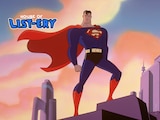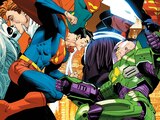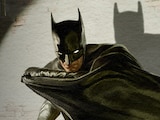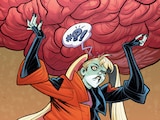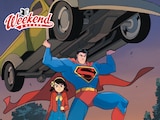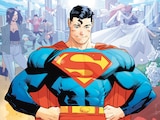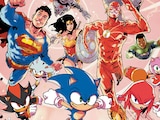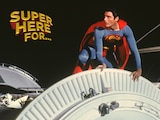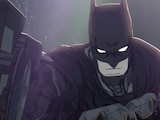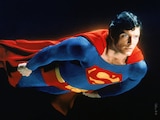DC’s line of Hanna-Barbera comic books is completely wild. These stories mark some of the most surprising and innovative comics that have come out over the last couple years. SCOOBY APOCALYPSE, written by Keith Giffen and J.M. DeMatteis and drawn by a variety of artists, was part of the first wave of Hanna-Barbera comics and has exploded out into an ongoing series that, if you ask me, not enough people are talking about. If you grew up watching Scooby-Doo the way that so many of us did, this series is recommended reading. You must read it—you must!
Volume 3 introduces us to one of the infamous Four—the four members of the Dinkley family responsible for the nanite plague that turned the world into ravenous monsters. Rufus Dinkley is the epitome of the sort of self-centered, powerful men who have been making the news more and more in recent years. While THE FLINTSTONES is the Hanna-Barbera title that I tend to think of when I think of artfully addressed social issues, I love that Giffen and DeMatteis took the opportunity with the character of Rufus Dinkley to reflect the birth of a pretty big social movement.

Velma and Daphne have been at the forefront of the Scooby Apocalypse franchise from the very beginning, but this third volume really cements these two women as the most capable of the gang. Personally, I love that Scooby Apocalypse puts women in the position of co-leaders, while the men are left to pick up the emotional slack. Volume 2 saw the women setting aside their differences and taking tentative steps toward a friendship and Volume 3 expands on that, largely through the eyes of their male counterparts.
The culmination of the Rufus storyline involves the Scooby gang adding a new member to the team: Daisy, Rufus’ beautiful, but abused wife with whom Shaggy is immediately smitten. This is a very literal representation of them stepping out from the fallen former society. Throughout the rest of the volume, both Velma and Daphne struggle with overreaching their expertise and assuming that they know what’s best. Meanwhile, the men, rather than asserting that they know best, instead often pick sides, debating whether it’s Daphne or Velma who truly has the strongest plan. The reality is that they all know best—the team is at its strongest when everyone is working together.
This volume also provides a resolution to the series’ Shaggy-Doo subplot. Shaggy has been a hero to the dogs of our now very wrecked world from the very beginning of the series and his emergence puts him under unique pressure in this situation.

Much like the cartoons, Scrappy is pretty unlikeable on the surface. He’s wild and vicious and claims a one-armed human child as his pet. However, when he shows up and—SPOILERS!—heroically sacrifices himself and almost manages to redeem a decades-long legacy of being irritable beyond belief, you can’t help but love the little guy.
Due to his injured leg (that I can’t believe has stuck around as long as it has and wasn’t just resolved with comic book timeline magic!), Fred remains stationary for most of this arc. He’s charged with watching Cliffy (the aforementioned one-armed boy), and must look outside of himself (and Daphne, of course) for the first time. Despite Fred being nothing like a natural parent, this is the type of growth that I, for one, never ever expected to see from a character I’ve known for such a long time. For much of the series, Fred has been the most one-note character—every decision he makes is based on his feelings for Daphne, that’s his sole motivation—but it seems like we’re starting to see him come into his own.

While Scooby Apocalypse Volume 3 continues the high-adventure and “monsterific” antics of the previous two volumes, it also brings with it a lot of character development that really snuck up on me over the course of the preceding volumes. Even better, it does it all under the auspices of some rad art from a number of contributing artists. Howard Porter’s established style is preserved in this volume while readers also get the chance to see how a collection of very talented artists view this dark, scary world. I, personally, love examining how each new artist renders Velma (have I given away by this point in the review that she’s my favorite character in the book?) and Scooby. The Smart Dogs always make for fun examination.
The third volume of Scooby Apocalypse brings the gang to yet another location, though this is one of sanctuary rather than growing danger. The safe haven is a common post-apocalyptic trope that is an interesting place to leave us before we launch into the fourth volume (can you believe there are soon to be four volumes of Scooby Apocalypse? How awesome?!), and I am really looking forward to discovering how this place is going to implode upon itself and where Scoob & Co. will wind up next!
SCOOBY APOCALYPSE VOL. 3 by Keith Giffen, J.M. DeMatteis and Dale Eaglesham is now available in print and as a digital download.
Ashley V. Robinson writes about DC Super Hero Girls and the DC Universe for DCComics.com and covers The Flash for the #DCTV Couch Club. Follow her on Twitter at @AshleyVRobinson.

